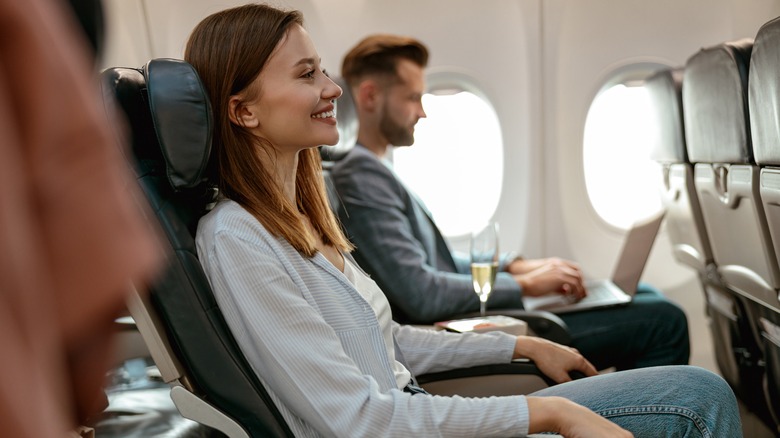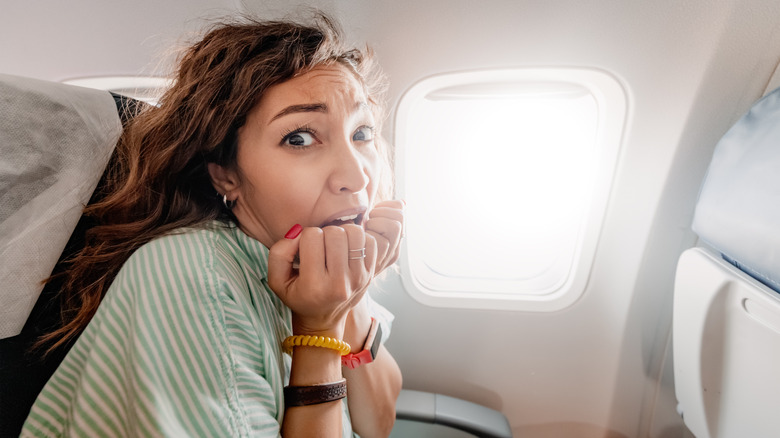The Odd Way You Should Sit During Takeoff And Landing, According To Flight Attendants
Fasten your seatbelt. Stow away all carry-on items. Turn off laptops and other large electronic devices. These instructions are part of the standard protocol many airlines enforce during takeoff and landing, arguably the most dangerous periods of a flight. According to data from Boeing, 46% of all fatal flight accidents take place during a plane's final approach and landing. Another 21% occur during takeoff and the initial climb. Those statistics are staggering, given that these phases account for only 6% of a 1.5-hour flight (and even less during a long-haul journey).
Clearly, following airline safety measures during takeoff and landing isn't just good etiquette — it can be the difference between life and death. But, according to some flight attendants, there's another safety technique you should follow that you've probably never thought of: the bracing position.
A flight attendant using the TikTok handle @_hennylim_ demonstrates the position in a video, showing two attendants buckled up in their seats while sitting on their hands. The posture may look unusual to passengers, but according to the TikToker, flight attendants use the position for an important reason.
Flight attendants use the bracing position for safety
In the TikTok clip, @_hennylim_ explains that cabin crew can often be seen using the bracing position during takeoff and landing, with their hands under their thighs and their feet planted flat on the floor. "The aim is to keep the body in a rigid pose so that if there was any impact from an unplanned emergency, the body is damaged less," the video's narrating voice says. With the hands held under the legs, the back and limbs are less likely to move and get injured during an accident, according to the flight attendant.
On most flights, passengers aren't expected to use the bracing position during takeoff and landing, though becoming familiar with the pose could be useful in case of a crash. Keep in mind, however, that the bracing position will look pretty different if your seat isn't equipped with the harness-style belt found on flight attendants' seats. "Passengers should bend as far forward as possible, [and] if it's in reach, they should rest their head against the seat in front, with hands placed on the back of their head," Steve Allright, a British Airways training captain, shared with The Sydney Morning Herald. "Hands should be placed on top of one another (not with fingers interlocked), elbows should be tucked in to their sides."
Does the bracing position really work?
For years, some skeptics have claimed the bracing position isn't intended to minimize injuries during a crash — it's designed to kill passengers quickly. This theory gained steam again as recently as 2023 when comedian Matt Rife explained the premise on an episode of "BFFs Podcast."
However, an operations bulletin released by the Federal Aviation Administration debunks this myth, confirming that the purpose of bracing positions is to "reduce flailing" and "reduce secondary impact" (such as hitting your head on an object or surface during the crash). The bulletin states that even when passengers don't have time to get in a full bracing position, an attempt at the position is likely to result in fewer injuries than if they don't change their posture at all.
In particular, the bracing position is intended to protect the neck, according to Boeing 747 pilot Nick Eades. He told LADbible, "What you're trying to do is to stop people breaking their necks in a big impact. [...] It's like whiplash – you're trying to avoid that sudden movement of the head, which can result in serious injury, if not death." A real-world example of the position's effectiveness was the 2009 emergency landing of US Airways Flight 1549 in the Hudson River. As passengers revealed to The New York Times after the crash, flight attendants told those on board how to get in the bracing position before the plane plunged into the river. Miraculously, all 155 passengers survived the impact.

